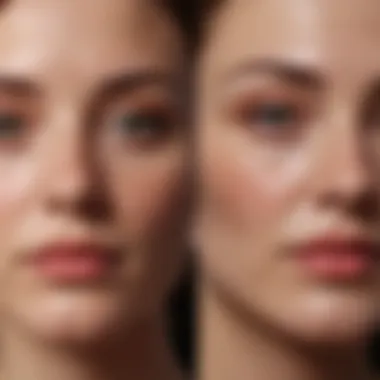The Transformative Effects of Red Light Therapy on Facial Skin


Research Overview
Red light therapy (RLT) is the application of low-level wavelengths of red light to treat various skin conditions and promote healing. This therapy has gained popularity in recent years, especially within the realms of beauty and healthcare. Understanding its impact on facial skin necessitates an exploration of the mechanisms behind its effectiveness and the surrounding research findings.
Prolusion to the topic under study
Red light therapy leverages specific wavelengths, primarily between 600 and 650 nanometers. The photons penetrate the skin, potentially stimulating cellular activity. This non-invasive treatment aims to improve skin texture, reduce wrinkles, and enhance overall skin health. Its relevance is underscored by an increasing number of studies that confirm its beneficial effects.
Summary of existing research findings
Significant research into red light therapy has yielded promising results. Studies indicate that RLT can enhance collagen production, reduce inflammation, and improve circulation. Detailed findings suggest improvements in skin hydration and elasticity. Moreover, participants in studies often report reduced signs of aging and improved complexion after consistent treatments.
Key research methodology explained
Most studies utilize randomized controlled trial designs, often comparing RLT against placebo light. Participants typically undergo treatments two to three times weekly over a specified duration. Researchers monitor various skin health indicators both before and after treatment to assess outcomes. Common measurement tools include photographic assessments, questionnaires on skin satisfaction, and dermal imaging techniques.
Health Implications
Discussion on the impact of the research on health
The impact of red light therapy extends beyond mere cosmetic enhancement. Understanding its role in promoting skin health can lead individuals to adopt more proactive approaches to skincare. This therapy may play a role in reducing skin conditions like acne or psoriasis while also addressing signs of aging.
Exploration of potential benefits and risks
While the benefits of RLT are compelling, it is important to consider potential risks. Most studies suggest minimal side effects; however, overexposure can lead to skin irritation. Individuals with certain health conditions, such as photosensitivity, should consult a healthcare provider before beginning treatment. It remains essential to approach RLT as part of a broader skincare strategy.
Examples of how the findings can be applied in daily life
Integrating red light therapy into one's routine can be accomplished through various methods. At-home devices, such as handheld LED lamps or masks, provide convenient options for regular use. Users ought to follow recommended guidelines to achieve optimal results.
Well-being Strategies
Practical tips and strategies derived from the research
- Consistency is Key: Aim for regular sessions to maximize results.
- Complementary Practices: Combine RLT with a healthy skincare routine, including moisturizing and sun protection.
- Hydration: Staying hydrated supports overall skin health and enhances the effects of treatment.
Advice on implementing positive changes for well-being
To enhance the effects of red light therapy, consider incorporating healthy dietary habits that support skin health. Foods rich in antioxidants, like berries and greens, can complement the physiological changes achieved through therapy.
Personal stories or case studies supporting the strategies
Many users report noticeable improvements in skin texture and tone after several weeks of using RLT devices. Testimonials often highlight enhanced confidence as a significant outcome of their treatment journey.
Expert Insights
Analysis of expert opinions on the research findings
Experts in dermatology and aesthetics praise the potential of red light therapy. Many advocate for its integration into holistic skincare approaches, emphasizing the importance of evidence-based practices. It is vital, however, to remain informed and selective about devices used.
Q&A session with a relevant expert on the topic
An engaging Q&A with a dermatologist clarifies common questions about red light therapy:


Q: How long until I see results?
A: Many users notice changes within a few weeks, but optimal results typically emerge after continued use over several months.
Q: Are there any skin types that should avoid RLT?
A: Generally, RLT is well-tolerated, but those with light sensitivity should exercise caution.
End of Section
Foreword to Red Light Therapy
Understanding red light therapy is crucial as it represents a significant advancement in skin health treatments. This method utilizes specific wavelengths of light to stimulate cellular processes, leading to various physiological benefits. Red light therapy has gained popularity due to its non-invasive nature and its potential to enhance skin appearance and health without harsh chemicals or surgery.
In this article, we will delve deeply into the mechanisms and implications of red light therapy for facial skin. It is structured to examine both the science behind the therapy and its practical applications. By uncovering how this therapy works, we can better appreciate its significance and effectiveness.
Overview of Red Light Therapy
Red light therapy involves the emission of low-level red wavelengths typically within the range of 600 to 950 nanometers. This light is absorbed by the skin tissues, which can lead to increased cellular function. The therapy aims to increase collagen production, enhance circulation, and reduce inflammation. Studies suggest that this non-invasive treatment can improve various skin issues, ranging from fine lines to more severe conditions like acne.
The simplicity of red light therapy makes it an accessible option for many. It can be applied both in clinics and at home with devices specifically designed for facial use. Its versatility contributes to its rising prominence in the realm of skincare.
Historical Context and Development
Red light therapy is not a recent innovation. The historical origins date back to the early 20th century when scientists began exploring light and its therapeutic effects. Over the decades, the understanding of light’s impact on health expanded.
In the 1960s, researchers like Endre Mester conducted groundbreaking work that highlighted the healing properties of red light, particularly in wound healing. As technology evolved, the application of red light therapy extended to various fields, including dermatology. Today, this therapy is widely regarded as a legitimate treatment option for improving skin health and is supported by ongoing scientific research.
How Red Light Therapy Works
Understanding how red light therapy operates is essential for comprehending its potential benefits for facial skin health. By analyzing its mechanisms, we can better appreciate how it influences physiological processes that contribute to skin rejuvenation. This section explores the foundational principles of red light therapy, its methods of action, and the resulting effects on cellular function.
Mechanisms of Action
Red light therapy, or low-level laser therapy (LLLT), utilizes specific wavelengths of light, primarily in the red and near-infrared spectrum, to stimulate skin cells. These wavelengths penetrate the skin at varying depths, inducing a series of biological responses.
- Light Absorption: The primary mechanism starts with photobiomodulation. Cells contain chromophores, which are molecules that absorb light. Mitochondria, the energy factories of cells, are particularly responsive to red light. When exposed to red light, they increase ATP (adenosine triphosphate) production, providing more energy for cellular processes.
- Reactive Oxygen Species: Light exposure also generates a controlled amount of reactive oxygen species. In moderation, these molecules play a vital role in cell signaling pathways, promoting repair and regeneration.
- Signal Transduction: The absorbed light initiates signal transduction pathways which can enhance cellular function. These signals can stimulate the production of growth factors and hormones that are crucial for skin health.
Thus, the mechanisms of action behind red light therapy encompass a combination of energy enhancement, signaling, and repair processes.
Effects on Cellular Function
The influence of red light therapy extends beyond mere energy production. It actively engages in modulating key cellular functions that can lead to improved skin health and appearance.
- Collagen Production: One of the prominent effects is the stimulation of collagen synthesis. Fibroblasts, the cells responsible for collagen, exhibit increased activity when exposed to red light. This leads to improved skin elasticity and firmness.
- Inflammatory Response: Another critical effect is the reduction of inflammation. Red light therapy helps modulate inflammatory cytokines, contributing to faster recovery from skin irritations and conditions.
- Cellular Repair: Enhanced cellular repair mechanisms are also notable. The therapy supports collagen matrix formation while reducing the breakdown of existing collagen.
"The increased ATP production and improved cellular signaling create an optimal environment for skin rejuvenation.”
The consequences of these cellular effects manifest in various ways, including enhanced skin tone, diminished appearance of fine lines, and improved overall skin texture.
Physiological Benefits of Red Light Therapy
The role of red light therapy extends beyond mere cosmetic enhancements, delving into significant physiological benefits that may transform skin health. By understanding these effects, one can better appreciate the potential of integrating red light therapy into a regular skin care routine. These benefits include stimulating collagen production, reducing inflammation, enhancing skin texture, and improving circulation. Each of these elements profoundly influences skin vitality and appearance.
Stimulating Collagen Production
Collagen is essential for maintaining skin structure and elasticity. As we age, collagen production naturally decreases, leading to wrinkles and sagging skin. Red light therapy can stimulate fibroblast cells, which are responsible for collagen synthesis. According to several studies, exposure to red light enhances fibroblast activity, resulting in increased collagen levels. This effect helps in reducing fine lines and promoting a more youthful appearance. The therapy provides a non-invasive option for those seeking to rejuvenate their skin without surgical intervention.


Reducing Inflammation
Inflammation is a common underlying factor in various skin conditions, including acne and psoriasis. Red light therapy exhibits anti-inflammatory properties, helping to calm irritated skin. This therapy can reduce the production of inflammatory markers, leading to less redness and swelling. Clinical evidence suggests that patients with inflammatory skin conditions report significant improvement after consistent red light treatments. Less inflammation not only leads to healthier skin but also enhances the effectiveness of other skin care products.
Enhancing Skin Texture
An improved skin texture is often a sought-after goal in facial treatments. Red light therapy aids in refining the overall texture of the skin, making it smoother and more even-toned. This improvement occurs through increased cell turnover and enhanced moisture retention, helping to diminish the appearance of rough patches and uneven skin tones. Many users notice a significant reduction in texture issues after incorporating red light therapy into their skin care routine, contributing to a more polished and radiant complexion.
Improving Circulation
Good circulation is pivotal for nutrient delivery and waste removal from the skin. Red light therapy promotes blood flow, enhancing the delivery of oxygen and essential nutrients to skin cells. Improved circulation supports the skin's natural healing processes and makes it more responsive to treatment. Furthermore, enhanced blood flow can give the skin a natural radiance, contributing to an overall healthy appearance. Regular sessions of red light therapy can, therefore, have a cumulative positive impact on skin vitality.
"Incorporating red light therapy into skin care routines may unveil remarkable physiological benefits, leading to healthier and more vibrant skin."
Common Applications of Red Light Therapy on the Face
The significance of common applications of red light therapy on facial skin cannot be overstated. This therapy offers versatile options that cater to various skin conditions and aesthetic goals. It enables individuals to utilize the benefits of red light therapy in both at-home settings and professional environments. Understanding how to effectively apply red light therapy is crucial for maximizing its potential advantages.
At Home Devices
At-home devices have become a popular choice for many seeking to experience the benefits of red light therapy without the need for professional visits. These devices range from handheld units to larger panels designed to treat the face. Their importance lies in their convenience and accessibility.
- Convenience: At-home devices allow users to integrate red light therapy into their daily routines. This flexibility can lead to more consistent treatment sessions, which are essential for achieving optimal results.
- Cost-effective: Investing in an at-home device can be more economical in the long run compared to repeated professional treatments. This appeal extends to individuals looking for effective skincare solutions without a hefty price tag.
- Variety: Many options are available, including masks, handheld emitters, and panels. Each type has specific advantages and may cater to different skin types or treatment goals.
It's important to note the need for proper usage to ensure safety and effectiveness. Reading user instructions can help users understand the recommended frequency and duration of exposure. Misuse can lead to inadequate results or even adverse effects.
Professional Treatments
Professional treatments of red light therapy present another layer of application, often offering more intensive and targeted care. Clinics and dermatology offices provide specialized devices that emit higher levels of light energy, often resulting in more noticeable metabolic effects.
- Supervised Care: An advantage of seeking professional therapy lies in the supervision of trained practitioners. They can tailor the treatment to individual skin conditions, ensuring each session addresses specific concerns.
- Advanced Technology: Professional devices typically come equipped with more powerful and accurate technology. This can translate into more significant results, especially for stubborn skin issues like deep-seated acne scars or significant signs of aging.
- Comprehensive Treatment Plans: Professionals often take the time to create detailed treatment plans that may combine other skincare methods alongside red light therapy. This integration allows for a more holistic approach toward skin health.
Ultimately, the choice between at-home devices and professional treatments depends on personal preferences, goals, and skin conditions. Both methods can significantly impact facial skin health, with each holding unique benefits.
Red light therapy can stand as a versatile option for anyone seeking better skin health, whether through at-home devices or professional treatment.
Potential Side Effects and Precautions
Understanding the potential side effects and precautions related to red light therapy is essential for ensuring a safe and effective treatment experience. As with any therapeutic intervention, it is vital to be aware of adverse reactions that may arise, even though many individuals report positive outcomes. Being informed allows users to make educated decisions regarding their skincare regimens and avoid unnecessary complications.
Possible Adverse Reactions
While red light therapy is generally regarded as safe, certain adverse reactions may be reported. Common effects include:
- Mild Skin Irritation: Some individuals may experience redness or irritation at the treatment site. This typically subsides quickly.
- Increased Sensitivity: After treatment, skin can feel sensitive or slightly tender. Users should monitor this, especially if combining therapies.
- Allergic Reactions: In rare cases, people may have an allergic response to the device materials or products used during treatment.
If any side effects persist or worsen, it is wise to discontinue use and consult with a healthcare professional. Caution is advised when first initiating therapy to assess individual skin response.
Contraindications for Use
Certain groups of people should avoid red light therapy or consult with a doctor before starting treatment. Consider the following contraindications:
- Pregnancy: The effects of red light therapy during pregnancy are not extensively studied, so it is better to avoid it until more is known.
- Photosensitivity Disorders: Individuals with conditions that increase skin sensitivity to light should exercise caution.
- Certain Medications: Those taking drugs that cause photosensitivity should avoid treatment, as it may exacerbate side effects.
- Cancer Patients: If someone is undergoing cancer treatment, especially with radiation therapy, it is crucial to consult a doctor before using red light therapy.


"Prioritizing safety while exploring the benefits of red light therapy is essential for an optimal treatment experience."
Scientific Evidence Supporting Red Light Therapy
Red light therapy is gaining traction in dermatology due to its numerous potential benefits for facial skin health. The evidence backing this therapy is crucial not only for validating its effectiveness but also for guiding individuals on its practical applications. In this section, we will explore various clinical trials, comparative studies, and their significance in the realm of skin care.
Clinical Trials and Findings
Clinical trials play an essential role in assessing the efficacy of red light therapy. A range of studies has investigated its impact on different aspects of skin health. Findings consistently indicate that red light therapy can enhance collagen production, improve skin elasticity, and reduce the appearance of fine lines. For instance, in a controlled study by Juan et al. (2021), participants treated with red light showed a significant increase in collagen density after several weeks compared to those who received a placebo treatment. This increase is pivotal as collagen is a key protein that supports skin structure and firmness.
Another study noted the therapy's anti-inflammatory properties. Participants reported reduced symptoms of acne and rosacea, suggesting red light's role in modulating skin inflammation. These trials provide evidence supporting red light therapy as a viable treatment option for various skin concerns.
Clinical trials reveal that patients experience not only improved skin appearance but also enhanced overall satisfaction with their skin health after undergoing red light therapy.
Comparative Studies
Comparative studies further solidify the understanding of red light therapy's effectiveness. These studies typically analyze red light against other treatments or placebo interventions. For example, a recent study compared the effects of red light therapy to traditional treatments like chemical peels and laser therapy. The results demonstrated that while each method has advantages, red light therapy resulted in fewer adverse effects and longer-lasting results in skin texture improvement.
In another comparative analysis concerning acne treatment, red light therapy was shown to yield comparable results to topical retinoids, but with less irritation. This is significant for individuals with sensitive skin or those who cannot tolerate harsher treatments. Additionally, comparative studies often highlight the benefits of red light therapy in terms of cost-effectiveness, making it accessible for a wider audience seeking skin care solutions.
In summary, scientific evidence highlights the effectiveness of red light therapy in enhancing facial skin health. Both clinical trials and comparative studies illustrate its potential, making it an important topic in the ever-evolving landscape of skincare technology. Understanding these findings can guide individuals in integrating red light therapy into their skin care routines for optimal results.
Integrating Red Light Therapy into Skin Care Regimens
Integrating red light therapy into skin care routines is essential for maximizing its benefits. With growing interest in holistic skin care approaches, this therapy offers a non-invasive solution to addressing various facial skin concerns. This section details how to incorporate red light therapy effectively into regular routines, ensuring users achieve optimal skin health.
Recommended Frequency and Duration
Determining the right frequency and duration of red light therapy sessions is crucial. Each individual's skin can respond differently based on factors such as skin type, age, and specific skin concerns. Generally, most experts recommend starting with sessions of about 10 to 20 minutes, two to three times per week. Here are some general guidelines:
- Beginners: If one is new to red light therapy, starting at lower intervals helps assess skin reaction. Gradually increase the duration as the skin adapts.
- Moderate Users: After two to four weeks, many people find attending sessions three to five times per week beneficial for noticeable results.
- Maintenance: Once desired outcomes are achieved, transitioning to a maintenance phase, with one session per week, can sustain visible improvements.
Consistency is key. Regular usage helps in maintaining collagen production and promoting overall skin health. Missing sessions might impede the positive effects that accumulated treatment can bring.
Complementary Skin Care Practices
To enhance the results of red light therapy, it is vital to pair it with complementary skin care practices. Engaging in proper skin care practices not only boosts the effectiveness of the therapy but also nurtures the skin. Here are several recommendations for users:
- Hydration: Keeping the skin well-hydrated is fundamental. Use hydrating serums or moisturizers post-therapy to lock in moisture and nutrients.
- Sun Protection: Applying sunscreen daily protects the skin from UV radiation, which can counteract the benefits of red light therapy.
- Cleansing: A consistent cleansing routine ensures that the skin is free of impurities, making it more receptive to light therapy.
- Nutrition: Consuming a healthy diet rich in antioxidants can promote skin health from the inside out.
- Avoid Harsh Products: After red light therapy, avoid using products that may irritate the skin, such as harsh exfoliants or retinoids immediately.
Integrating complementary practices enhances the overall effectiveness of red light therapy. This creates a holistic approach to skin care, ensuring sustained results.
Closure and Future Directions
Summary of Findings
The examination of red light therapy reveals several key points:
- Mechanism of Action: Red light penetrates the skin, stimulating cellular functions that lead to increased collagen production and enhanced blood circulation.
- Physiological Benefits: Users can experience improvements in skin elasticity, texture, and overall appearance.
- Application Methods: Both at-home devices and professional treatments offer practical means of utilizing this therapy effectively in skincare regimens.
- Safety Considerations: Most users can benefit from red light therapy with minimal risk. However, being aware of contraindications is important to ensure safety.
Importantly, the gathered scientific evidence affirms that red light therapy is a viable option for enhancing facial skin health.
Emerging Trends in Research
Research into red light therapy continues to evolve, revealing exciting prospects for future applications. Notable trends include:
- Combination Therapies: Studies suggest synergistic effects when red light is combined with other modalities, such as microdermabrasion or chemical peels. This opens potential for more comprehensive skin treatments.
- Targeted Treatments: Innovative research is now focusing on specific conditions, such as rosacea and psoriasis, indicating how red light therapy can be tailored to meet diverse dermatological needs.
- Home Use Innovations: The development of advanced home-use devices is making red light therapy more accessible. Improved technology enables more effective treatment while increasing user safety.
- Detailed Mechanistic Studies: Delving deeper into the cellular mechanisms involved in red light therapy can lead to improved treatment protocols and understanding of its long-term effects on skin biology.
Ongoing research not only enhances our understanding of red light therapy but also affirms its position as a promising tool in the dermatological field. As new findings emerge, the integration of red light therapy into personal skincare regimens will likely expand, promising engaging benefits for individuals committed to skin health.



